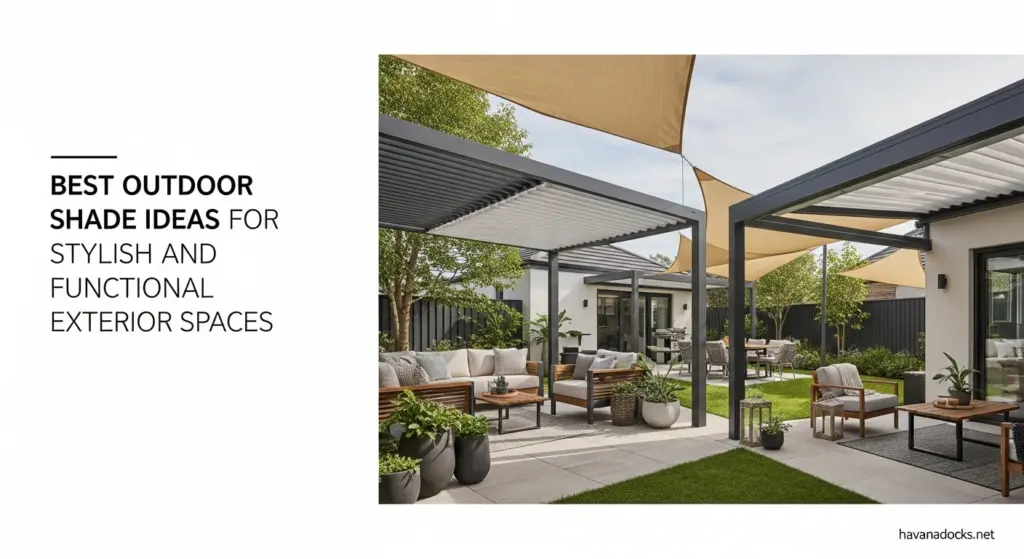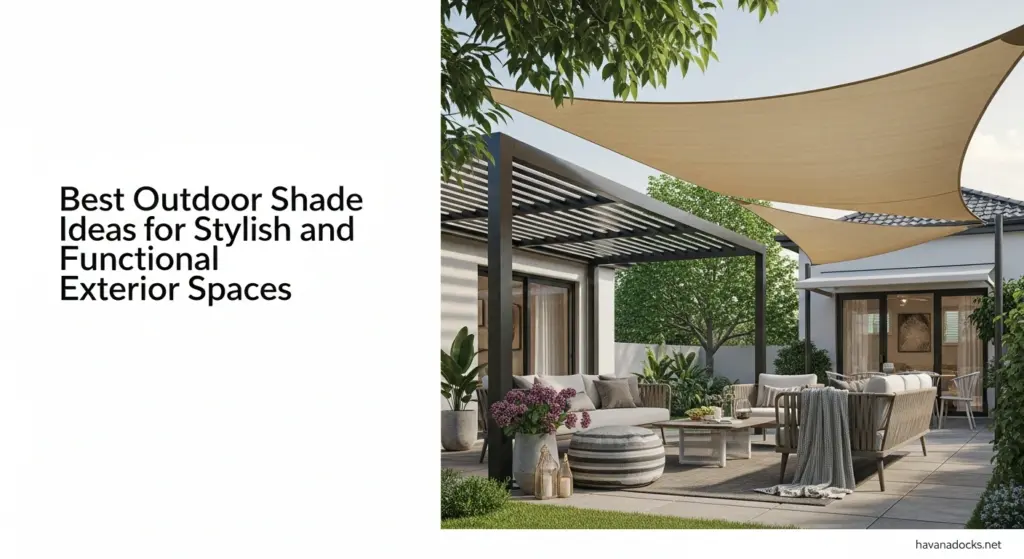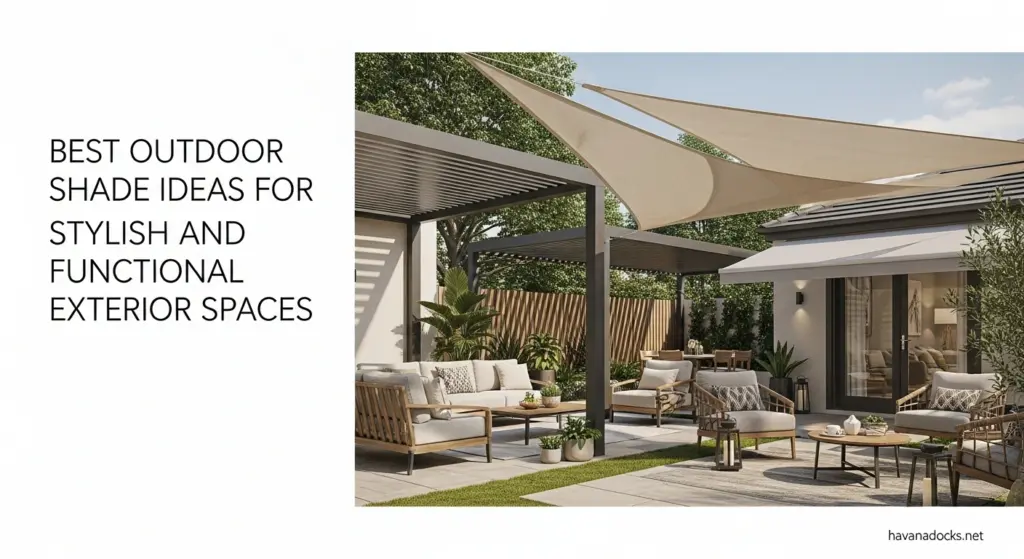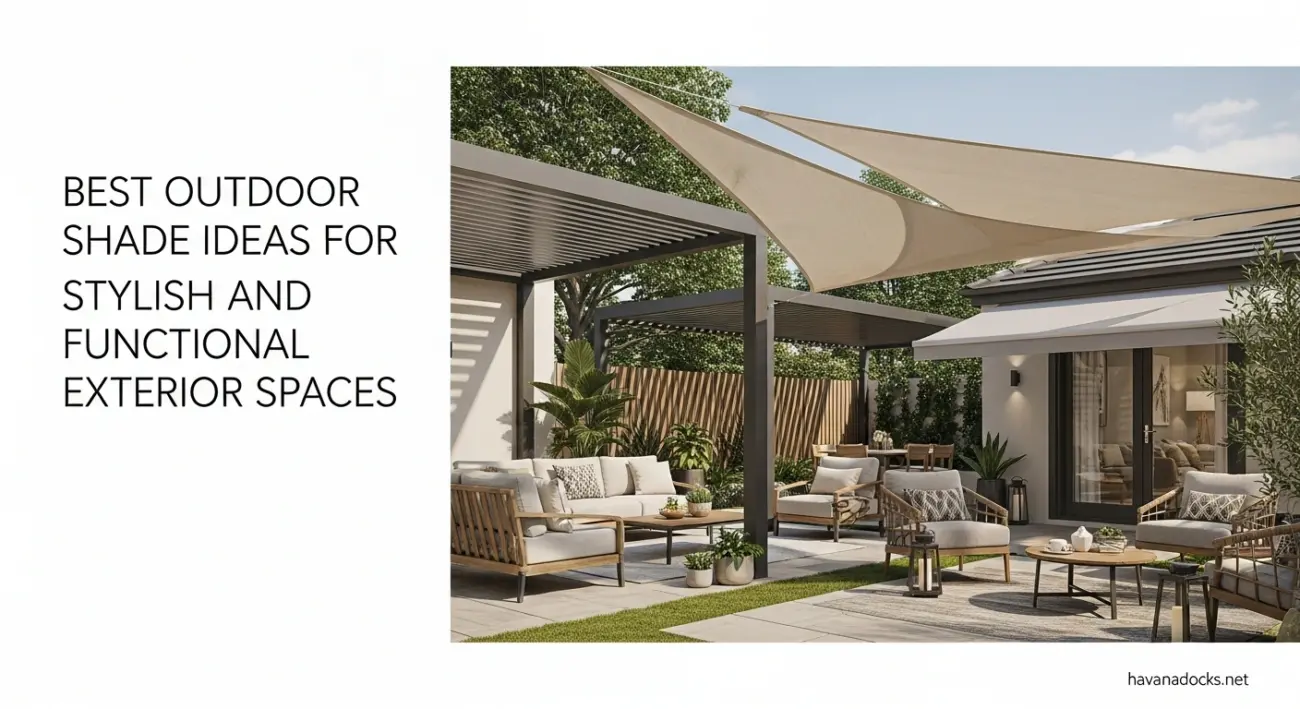Best Outdoor Shade Ideas for Stylish and Functional Exterior Spaces
Understanding Your Outdoor Shade Needs
Before diving into specific outdoor shade ideas, it’s essential to assess your needs and preferences carefully. Consider the following factors:
- Sun Exposure: How much direct sunlight does your outdoor space receive throughout the day? Identify the areas that require the most shade during peak hours. The direction of the sun will influence the best angles for your shade structure. Think about westward-facing patios which will require better shade coverage in the afternoons.
- Climate: Consider your local climate. Do you live in a region with frequent rain, strong winds, or intense heat? Choose shade solutions that can withstand the elements and provide adequate protection. Coastal locations might need extra durable materials to combat salt spray and wind.
- Space Availability: The size and layout of your outdoor space will dictate the type and size of shade structures you can accommodate. Measure your area and consider any existing landscaping or architectural features.
- Budget: Establish a realistic budget for your outdoor shade project. Prices can range from affordable umbrellas to more expensive custom-built structures.
- Style and Aesthetics: Choose shade solutions that complement your home’s architectural style and your personal taste. Consider the color, materials, and overall design of the shade structure. Do you have a modern home? You might prefer sleek, minimalist designs. A traditional home would pair well with a classic pergola or canvas awning.

Types of Outdoor Shade Structures: A Comprehensive Overview
Now that you understand your needs, let’s explore the various types of outdoor shade ideas available.
Umbrellas: Portable and Versatile Shade
- Description: Umbrellas are a classic and cost-effective shade solution, offering portability and easy setup. They are available in various sizes, shapes, and materials. Freestanding umbrellas are a versatile option.
- Pros: Affordable, portable, easy to install, readily available in a wide range of styles and colors.
- Cons: Can be unstable in windy conditions, limited coverage area, may require a heavy base for stability. Many cheaper models don’t hold up well over time.
- Best for: Small patios, decks, balconies, or poolside areas where you need flexible shade options. Consider cantilevered umbrellas for larger areas.
Awnings: Retractable Shade and Weather Protection
- Description: Awnings are fabric or metal coverings that extend from a wall or roof, providing shade and protection from the elements. Retractable awnings offer the flexibility to adjust the amount of shade as needed.
- Pros: Provides significant shade coverage, protects from rain and sun, can be retracted when not needed, enhances curb appeal. Motorized awnings offer ease of use.
- Cons: Can be expensive to install, requires professional installation, may require maintenance, susceptible to wind damage if not retracted properly.
- Best for: Decks, patios, and windows where you want convenient and adjustable shade and protection from the elements.
Pergolas: Elegant Structures for Shaded Retreats
- Description: Pergolas are open-roofed structures supported by columns or posts, creating a shaded area with an airy and elegant feel. They are often constructed from wood, metal, or vinyl.
- Pros: Adds architectural interest to your outdoor space, provides partial shade, can be customized with climbing plants for natural shade, allows for airflow.
- Cons: Offers limited sun protection without additional coverings, requires construction and planning, can be expensive depending on size and materials.
- Best for: Patios, gardens, and outdoor dining areas where you want a stylish and semi-shaded space.
Gazebos: Enclosed Shelters for All-Weather Enjoyment
- Description: Gazebos are freestanding, enclosed structures with a roof, offering complete protection from the sun and rain. They are typically octagonal or circular in shape.
- Pros: Provides complete shelter from the elements, creates a private and comfortable outdoor space, adds architectural elegance, can be equipped with screens for insect protection.
- Cons: More expensive than other shade options, requires significant space, can block views, may require building permits.
- Best for: Large yards or gardens where you want a dedicated outdoor entertaining space shielded from the elements.
Shade Sails: Modern and Geometric Shade Solutions
- Description: Shade sails are triangular or rectangular pieces of fabric that are suspended between multiple anchor points, creating a geometric and modern shade structure.
- Pros: Affordable, easy to install, provides a contemporary look, offers good shade coverage, allows for airflow.
- Cons: Requires secure anchor points, may not be suitable for windy conditions, limited protection from rain, can sag over time. The design can restrict placement options.
- Best for: Decks, patios, and poolside areas where you want a stylish and affordable shade solution.

Temporary Shelters: Easy to Assemble and Transport
- Description: Temporary shelters, such as pop-up canopies and portable pavilions, are lightweight and easy to assemble, offering temporary shade protection for events or gatherings.
- Pros: Affordable, portable, easy to set up and take down, provides temporary shade for events.
- Cons: Not designed for long-term use, susceptible to wind damage, may not be as aesthetically pleasing as permanent structures.
- Best for: Outdoor events, parties, picnics, or temporary shade needs.
Exploring Materials for Outdoor Shade Structures
The choice of materials significantly impacts the durability, aesthetics, and maintenance requirements of your outdoor shade ideas.
Wood: Classic and Natural
- Description: Wood is a classic and versatile material for pergolas, gazebos, and other shade structures. Cedar, redwood, and pressure-treated lumber are popular choices due to their natural resistance to decay and insects.
- Pros: Natural beauty, adds warmth and character to your outdoor space, can be stained or painted to match your home’s exterior.
- Cons: Requires regular maintenance, such as staining or sealing, susceptible to rot and insect damage if not properly treated, can be more expensive than other materials.
Metal: Durable and Modern
- Description: Metal, such as aluminum and steel, is a durable and low-maintenance material for shade structures. Aluminum is lightweight and rust-resistant, while steel is stronger and can withstand heavy loads.
- Pros: Durable, low-maintenance, modern aesthetic, can be powder-coated in various colors, resists rot and insect damage.
- Cons: Can get hot in direct sunlight, may require professional installation, can be more expensive than wood.
Fabric: Versatile and Affordable
- Description: Fabric is a versatile and affordable material for umbrellas, awnings, and shade sails. Acrylic, polyester, and canvas are popular choices for their UV resistance, water repellency, and durability.
- Pros: Wide range of colors and patterns, relatively inexpensive, easy to clean, provides good shade coverage.
- Cons: Can fade or tear over time, may require replacement, susceptible to mold and mildew if not properly maintained.
Vinyl: Low-Maintenance and Weather-Resistant
- Description: Vinyl is a low-maintenance and weather-resistant material for pergolas, gazebos, and other shade structures. It is available in various colors and styles, mimicking the look of wood without the maintenance.
- Pros: Low-maintenance, weather-resistant, resists rot and insect damage, easy to clean, affordable.
- Cons: Can look less natural than wood, susceptible to fading over time, may not be as strong as wood or metal.
Incorporating Natural Shade Ideas
Beyond traditional structures, consider incorporating natural elements to enhance your outdoor shade ideas.
Trees: A Natural Canopy of Shade
- Description: Planting trees strategically around your outdoor space can provide natural shade and create a cooling effect. Choose trees with dense canopies and appropriate height for your location.
- Pros: Provides natural shade, cools the surrounding air, adds beauty and biodiversity to your landscape, can improve air quality.
- Cons: Takes time to grow and mature, requires regular pruning and maintenance, may drop leaves and debris.
- Best for: Large yards where you have space for trees to grow and spread.
Vines: Climbing Shade for Pergolas and Walls
- Description: Climbing vines, such as wisteria, clematis, and grapevines, can be trained to grow over pergolas, trellises, and walls, creating a natural and beautiful shade.
- Pros: Provides natural shade, adds beauty and fragrance to your outdoor space, can create a living wall or roof, relatively inexpensive.
- Cons: Requires regular pruning and training, can be invasive if not properly managed, may attract insects.
- Best for: Pergolas, trellises, and walls where you want a natural and climbing shade solution.
Hedges and Shrubs: Privacy and Shade
- Description: Planting hedges and shrubs around your outdoor space can provide privacy and shade, creating a green and natural barrier from the sun.
- Pros: Provides privacy and shade, adds beauty and structure to your landscape, can act as a windbreak, relatively low-maintenance.
- Cons: Takes time to grow and mature, requires regular pruning, may attract insects.
- Best for: Creating privacy screens, defining borders, and providing shade along the perimeter of your outdoor space.
Design Considerations for Stylish Outdoor Shade
Creating a stylish and functional outdoor space requires careful consideration of design principles.
Scale and Proportion
- Choose shade structures that are appropriately sized for your outdoor space. A large pergola can overwhelm a small patio, while a small umbrella may not provide adequate shade for a group of people.
- Maintain a sense of proportion between the shade structure and other elements in your outdoor space, such as furniture, landscaping, and architectural features.
Color and Texture
- Select colors and textures that complement your home’s exterior and your personal style. Neutral colors, such as beige, gray, and white, are versatile and can blend seamlessly with most landscapes.
- Introduce pops of color with cushions, planters, and other accessories.
- Consider the texture of the shade material. For example, a woven fabric can add warmth and visual interest, while a smooth metal finish can create a modern look.
Lighting
- Incorporate lighting into your shade structure to create ambiance and extend the usability of your outdoor space into the evening.
- String lights, lanterns, and recessed lighting are popular options for pergolas and gazebos.
- Under-mount lighting can illuminate the underside of an umbrella or awning.
- Solar-powered lights are an eco-friendly and cost-effective option.
Furniture and Accessories
- Choose furniture that is comfortable, durable, and appropriate for outdoor use.
- Consider the style of your shade structure and select furniture that complements its design.
- Accessorize your outdoor space with cushions, rugs, planters, and other decorative items to create a cohesive and inviting atmosphere.
Landscaping
- Integrate landscaping strategically around your shade structure to enhance its beauty and functionality.
- Plant flowers, shrubs, and trees to create a lush and inviting environment.
- Consider using potted plants to add greenery and color to your patio or deck.
- Incorporate natural elements, such as rocks and water features, to create a tranquil and relaxing space.
Installation Tips for Outdoor Shade Structures
Proper installation is crucial for the safety, durability, and performance of your outdoor shade ideas.
Permits and Regulations
- Check with your local building department to determine if you need permits for your shade structure.
- Be aware of any zoning regulations or homeowner association rules that may affect your project.
Foundation and Support
- Ensure that your shade structure has a solid foundation and adequate support.
- For pergolas and gazebos, consider using concrete footings or piers to provide a stable base.
- For umbrellas, use a heavy base to prevent tipping in windy conditions.
- For shade sails, use strong anchor points, such as trees, buildings, or posts.
Safety Precautions
- Follow all safety guidelines provided by the manufacturer.
- Wear appropriate safety gear, such as gloves, eye protection, and a hard hat.
- Use the proper tools and equipment for the job.
- If you are not comfortable with DIY installation, hire a professional contractor.
Maintenance and Care
- Regularly clean your shade structure to remove dirt, debris, and stains.
- Inspect your shade structure for signs of damage, such as rot, rust, or tears.
- Repair any damage promptly to prevent further deterioration.
- Store umbrellas and awnings properly during the off-season to protect them from the elements.
- Prune trees and vines regularly to maintain their shape and prevent them from becoming overgrown.
Specific Outdoor Shade Ideas for Different Spaces
Now let’s tailor some outdoor shade ideas to specific areas:
Patio Shade Ideas
- Retractable Awnings: A practical choice attached to your home. They extend to provide shade and retract when not needed.
- Pergolas with Shade Cloth: Combine architectural interest with adjustable shade using shade cloth or retractable canopies.
- Freestanding Umbrellas: Easily movable and offer targeted shade where needed.
- Shade Sails: Provide a modern and geometric touch, perfect for adding visual appeal.
- Strategically Planted Trees: Over time, create a natural canopy offering cool respite.
Deck Shade Ideas
- Cantilevered Umbrellas: Provide shade without a central pole obstructing walkways.
- Deck-mounted Awnings: Specifically designed to attach to deck railings or posts.
- Shade Sails with Multiple Attachment Points: Create interesting shade patterns and configurations.
- Pergolas integrated into the Deck Design: Enhance the architectural flow and create a unified space.
- Potted Plants with Trellises: Use climbing plants for a mobile and adaptable shade screen.
Pool Shade Ideas
- Large Umbrellas with Heavy Bases: Offer plenty of shade near lounge chairs.
- Cabanas: Provide a luxurious and private shaded retreat.
- Shade Sails Suspended Over the Pool Deck: Offer sun protection without blocking views.
- Pergolas with Water-Resistant Fabric Canopies: Combine shade with an elegant architectural element.
- Palm Trees or Other Tropical Vegetation: Evoke a relaxing resort-like atmosphere.
Balcony Shade Ideas
- Market Umbrellas: Compact and provide decent shade for small spaces.
- Balcony Awnings: Designed for smaller areas, offering retractable shade.
- Shade Sails Attached to Balcony Railings: Create a modern and stylish look.
- Privacy Screens with Built-in Shade: Enhance both privacy and sun protection.
- Climbing Vines on Trellises: Add vertical greenery and create a cooling effect.
Garden Shade Ideas
- Gazebos: Ideal for creating a secluded and shaded retreat within the garden.
- Pergolas Covered with Climbing Plants: Offer a natural and romantic ambiance.
- Arbors: Create shaded walkways.
- Fruit Trees with Dense Canopies: Practical and aesthetically pleasing option.
- Shade Cloth Structures: Protect delicate plants from harsh sunlight.
Combining Functionality with Aesthetics
Blending functionality with aesthetics in outdoor shade ideas is crucial for creating a space that’s both comfortable and visually appealing. Consider the flow of your outdoor space.
The Importance of Professional Planning and Consultation
While some outdoor shade ideas can be implemented as DIY projects, others require professional planning and consultation. For larger structures or those involving electrical or plumbing work, it’s best to enlist the expertise of qualified professionals. This ensures that the project meets all safety codes and is built to last.

Cost Considerations for Outdoor Shade Solutions
The cost of outdoor shade ideas can vary widely depending on the type of structure, materials used, and installation complexity.
- Budget-Friendly Options: Umbrellas and shade sails are generally the most affordable options, with prices ranging from a few hundred dollars to a few thousand.
- Mid-Range Options: Awnings and pergolas fall into the mid-range category, with prices ranging from several thousand dollars to tens of thousands.
- High-End Options: Gazebos and custom-built shade structures can be the most expensive, with prices ranging from tens of thousands to hundreds of thousands.
Consider the long-term cost-effectiveness of each option. While a cheaper umbrella might seem appealing initially, it may not last as long as a more durable awning or pergola. Factor in maintenance costs, potential repairs, and replacement costs when making your decision.
Conclusion
Choosing the best outdoor shade ideas requires careful consideration of your needs, preferences, and budget. By exploring the various types of shade structures, materials, and design considerations outlined in this guide, you can create a stylish and functional outdoor space that enhances your enjoyment of your property for years to come. From the simplicity of umbrellas to the elegance of pergolas and the modern appeal of shade sails, the possibilities are endless.
Remember to prioritize quality, durability, and aesthetics when making your selection, and don’t hesitate to consult with professionals for guidance and installation assistance. Transform your backyard into a comfortable and inviting oasis where you can relax, entertain, and enjoy the beauty of nature, all while staying protected from the sun’s harmful rays.


